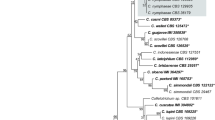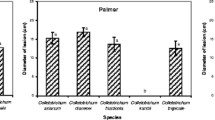Abstract.
Colletotrichum gloeosporioides is a major fungal pathogen of avocado and mango fruit in Australia and overseas. It causes anthracnose and stem-end rot in these crops but has also been identified as the causal pathogen of pepper spot of avocado and tear stain of mango. Research was initiated to determine the pathogenic diversity of pepper spot, with emphasis on avocado. Eighty C. gloeosporioides isolates obtained from avocado and mango fruit showing anthracnose and pepper spot symptoms were screened for pathogenicity, comparative aggressiveness and cross-infection potential by inoculating onto detached avocado and mango fruit, avocado leaf petioles and branches of young, grafted nursery trees, as well as avocado fruit and pedicels still attached to the tree. On detached, ripening avocado and mango fruit in the laboratory, it was found that pepper spot isolates were as capable as anthracnose isolates of causing anthracnose lesions. However, avocado isolates were significantly (P < .05) more aggressive than mango isolates on avocado fruit and mango isolates were significantly (P < 0.05) more aggressive than avocado isolates on mango fruit. In field inoculations, pepper spots were formed on developing avocado fruit and pedicels on the tree. Likewise, pepper spots developed on petioles and branches of nursery avocado trees, but not on their leaves. When all isolates were grouped according to symptom or host of origin, significant differences in lesion severity were demonstrated between isolates on avocado petioles in the glasshouse, with avocado pepper spot isolates being the most aggressive, followed by avocado anthracnose isolates then mango isolates from both anthracnose and pepper spot, respectively. On unripe avocado fruit in the field, the pattern was generally similar with the mango isolates being the least aggressive. There were more and less pathogenic strains present in the pathogen populations from both mango fruit and avocado fruit but neither were restricted to anthracnose or pepper spot groupings. Generally, a higher percentage of the most aggressive isolates was from avocado pepper spot. When isolates were grouped according to the orchard of origin, there were significant differences in aggressiveness to avocado both in the glasshouse and the field.
Similar content being viewed by others
References
Abang MM, Winter S, Green KR, Hoffmann P, Mignouna HD, Wolf GA (2002) Molecular identification of Colletotrichum gloeosporioides causing yam anthracnose in Nigeria. Plant Pathology 51, 63–71. doi: 10.1046/j.0032-0862.2001.00655.x
Adaskaveg JE, Hartin RJ (1997) Characterisation of Colletotrichum acutatum isolates causing anthracnose of almond and peach in California. Phytopathology 87, 979–987. doi: 10.1094/PHYTO.1997.87.9.979
Afanador-Kafuri L, Minz D, Maymon M, Freeman S (2003) Characterisation of Colletotrichum isolates from tamarillo, passiflora, and mango in Colombia and identification of a unique species from the genus. Phytopathology 93, 579–587. doi: 10.1094/PHYTO.2003.93.5.579
Alahakoon PW, Brown AE, Sreenivasaprasad S (1994a) Cross-infection potential of genetic groups of Colletotrichum gloeosporioides on tropical fruit. Physiological and Molecular Plant Pathology 44, 93–103. doi: 10.1016/S0885-5765(05)80104-3
Alahakoon PW, Brown AE, Sreenivasaprasad S (1994b) Genetic characterisation of Colletotrichum gloeosporioides isolates obtained from mango. International Journal of Pest Management 40, 225–229. doi: 10.1080/09670879409371887
Ansari KI, Palacios N, Araya C, Langin T, Egan D, Doohan FM (2004) Pathogenic and genetic variability among Colletotrichum Lindemuthianum isolates of different geographic origins. Plant Pathology 53, 635–642. doi: 10.1111/j.0032-0862.2004.01057.x
Ardi R, Kobiler I, Jacoby B, Keen NT, Prusky D (1998) Involvement of epicatechin biosynthesis in the activation of the mechanism of resistance of avocado fruit to Colletotrichum gloeosporioides. Physiological and Molecular Plant Pathology 53, 269–285. doi: 10.1006/pmpp.1998.0181
Boesewinkel HJ (1976) Storage of fungal cultures in water. Transactions of the British Mycological Society 66, 183–185.
Bower JP, Cutting JGM (1988) Avocado fruit development and ripening physiology. Horticultural Reviews 10, 229–271.
Carman RM, Handley PN (1999) Antifungal diene in leaves of various avocado cultivars. Phytochemistry 50, 1329–1331. doi: 10.1016/S0031-9422(98)00348-3
Chakraborty S, Perrott R, Ellis N, Thomas MR (1999) New aggressive Colletotrichum gloeosporioides strains on Stylosanthes scabra detected by virulence and DNA analysis. Plant Disease 83, 333–340. doi: 10.1094/PDIS.1999.83.4.333
Coates LM, Muirhead IF, Irwin JAG, Gowanlock DH (1993) Initial infection processes by Colletotrichum gloeosporioides on avocado fruit. Mycological Research 97, 1363–1370. doi: 10.1016/S0953-7562(09)80171-8
Dodd JC, Prusky D, Jeffries P (1997) Fruit diseases. In ‘The mango: botany, production and uses’. (Ed. RE Litz) pp. 257–280. (CAB International: Wallingford, UK)
Droby S, Prusky D, Jacoby B, Goldman A (1987) Induction of antifungal resorcinols in flesh of unripe mango fruit and its relation to latent infection by Alternaria alternata. Physiological and Molecular Plant Pathology 30, 285–292. doi: 10.1016/0885-5765(87)90041-5
Fitzell RD (1987) Epidemiology of anthracnose disease of avocados. South African Avocado Growers’ Association Yearbook 10, 113–116.
Flaishman MA, Kolattukudy PE (1994) Timing of fungal invasion using host’s ripening hormone as a signal. Proceedings of the National Academy of Sciences of the United States of America 91, 6579–6583. doi: 10.1073/pnas.91.14.6579
Freeman S (2000) Genetic diversity and host specificity of Colletotrichum species on various fruits. In ‘Colletotrichum: host specificity, pathology, and host-pathogen interaction’. (Eds D Prusky, S Freeman, MB Dickman) pp. 131–144. (APS Press: St Paul, MN)
Freeman S, Shabi E (1996) Cross-infection of subtropical and temperate fruit by Colletotrichum species from various hosts. Physiological and Molecular Plant Pathology 49, 395–404. doi: 10.1006/pmpp.1996.0062
Freeman S, Katan T, Shabi E (1996) Characterisation of Colletotrichum Gloeosporioides isolates from avocado and almond fruit with molecular and pathogenicity tests. Applied and Environmental Microbiology 62, 1014–1020.
Freeman S, Katan T, Shabi E (1998) Characterisation of Colletotrichum species responsible for anthracnose diseases of various fruit. Plant Disease 82, 596–605. doi: 10.1094/PDIS.1998.82.6.596
Giblin FR (2006) Avocado fruit responses to Colletotrichum gloeosporioides. PhD Thesis, CRCfor Tropical Plant Protection, University of Queensland, Brisbane.
Hassan MK, Dann EK, Irving DE, Coates LM (2007) Concentrations of constitutive alk(en)ylresorcinols in peel of commercial mango varieties and resistance to postharvest anthracnose. Physiological and Molecular Plant Pathology 71, 158–165. doi: 10.1016/j.pmpp.2007.12.005
Hayden HL, Pegg KP, Aitken EAB, Irwin JAG (1994) Genetic relationships as assessed by molecular markers and cross-infection among strains of Colletotrichum gloeosporioides. Australian Journal of Botany 42, 9–18. doi: 10.1071/BT9940009
Heath MC (1999) The enigmatic hypersensitive response: induction, execution, and role. Physiological and Molecular Plant Pathology 55, 1–3. doi: 10.1006/pmpp.1999.0217
Hodson A, Mills PR, Brown AE (1993) Ribosomal and mitochondrial DNA polymorphisms in Colletotrichum gloeosporioides isolated from tropical fruits. Mycological Research 97, 329–335. doi: 10.1016/S0953-7562(09)81130-1
Lam E, Kato N, Lawton M (2001) Programmed cell death, mitochondria and the plant hypersensitive response. Nature 411, 848–853. doi: 10.1038/35081184
Manners JM, Stephenson SA, He C, Maclean DJ (2000) Gene transfer and expression in Colletotrichum gloeosporioides causing anthracnose on Stylosanthes. In ‘Colletotrichum: host specificity, pathology, and hostpathogen Interaction’. (Eds D Prusky, S Freeman, MB Dickman) pp. 180–194. (APS Press: St Paul, MN)
Mills PR, Hodson A, Brown AE (1992) Molecular differentiation of Colletotrichum gloeosporioides isolates infecting tropical fruit. In ‘Colletotrichum: biology, pathology and control’. (Eds JA Bailey, MJ Jeger) pp. 269–288. (CAB International: Wallingford, UK)
Mittler R, Shulaev V, Seskar M, Lam E (1996) Inhibition of programmed cell death in tobacco plants during a pathogen-induced hypersensitive response at low oxygen pressure. The Plant Cell 8, 1991–2001.
Prusky D, Keen NT, Sims JJ, Midland SL (1982) Possible involvement of an antifungal diene in the latency of Colletotrichum gloeosporioides on unripe avocado fruit. Phytopathology 72, 1578–1582. doi: 10.1094/Phyto-72-1578
Sutton BC (1980) The Coelomycetes: fungi imperfecti with pycnidia, acervuli and stromata.’ Commonwealth Mycological Institute: Kew, UK
Than PP, Jeewon R, Hyde KD, Pongsupasamit S, Mongkolporn O, Taylor PWJ (2008) Characterization and pathogenicity of Colletotrichum species associated with anthracnose on chilli (Capsicum spp.) in Thailand. Plant Pathology 57, 562–572. doi: 10.1111/j.1365-3059.2007.01782.x
Waller JM, Bridge PD (2000) Recent advances in understanding Colletotrichum diseases of some tropical perennial crops. In ‘Colletotrichum: host specificity, pathology, and host-pathogen Interaction’. (Eds D Prusky, S Freeman, MB Dickman) pp. 337–345. (APS Press: St Paul, MN)
Whitaker D, Williams ER, John JA (2001) ‘CycDesigN: a package for the computer generation of experimental designs.’ (CSIRO Forestry and Forest Products: Canberra)
Willingham SL, Cooke AW, Coates LM, Pegg KP (2000) Pepper spot: a new preharvest Colletotrichum disease of avocado cv. Hass. Australasian Plant Pathology 29, 151. doi: 10.1071/AP00025
Willingham SL, Pegg KP, Cooke AW, Coates LM, Langdon PWB, Dean JR (2001) Rootstock influences postharvest anthracnose development in ‘Hass’ avocado. Australian Journal of Agricultural Research 52, 1017–1022. doi: 10.1071/AR01015
Author information
Authors and Affiliations
Corresponding author
Rights and permissions
About this article
Cite this article
Giblin, F.R., Coates, L.M. & Irwin, J.A.G. Pathogenic diversity of avocado and mango isolates of Colletotrichum gloeosporioides causing anthracnose and pepper spot in Australia. Australasian Plant Pathology 39, 50–62 (2010). https://doi.org/10.1071/AP09055
Received:
Accepted:
Issue Date:
DOI: https://doi.org/10.1071/AP09055




